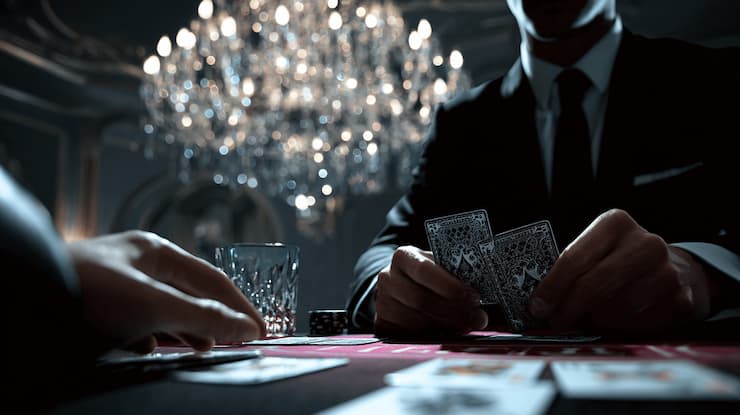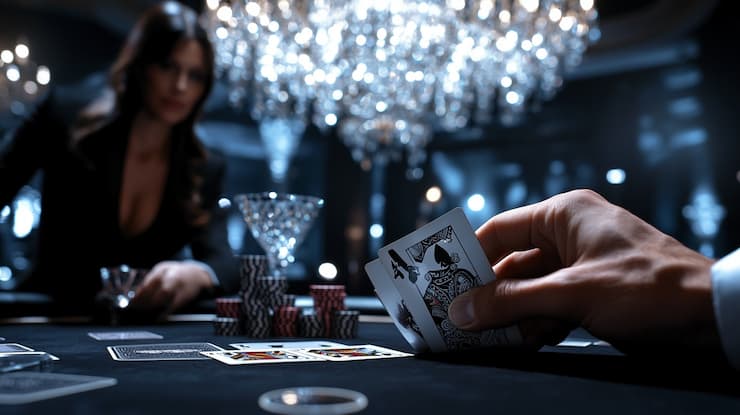When to split in blackjack can be the difference between walking away with a profit and giving the house an edge. Knowing the right time to split and when to hold back is a key part of smart, strategic play.
Let’s start with the basics.
In This Article
- When to Split in Blackjack: Understanding What It Means
- Blackjack Splitting Rules Explained
- When to Split in Blackjack (Best Scenarios)
- When Not to Split in Blackjack
- Blackjack Pair Splitting Chart
- Benefits of Splitting in Blackjack
- Special Splitting Scenarios
- Final Thoughts: Make the Right Split Every Time
- FAQ: When to Split in Blackjack
When to Split in Blackjack: Understanding What It Means
In blackjack, a split happens when you’re dealt two cards of the same value — like two 8s or two Kings. Instead of playing them as one hand, you can split them into two separate hands. At a BJ table, you communicate your intention to split by placing additional bets and using specific hand signals to inform the dealer.
To do this, you place a second bet equal to your original wager. Splitting requires placing additional bets, and each split creates two split cards, which are then played as separate hands. Each new hand then receives an additional card, and you play both hands independently. Splitting gives you the chance to turn a weak start into two potentially winning hands.
Blackjack Splitting Rules Explained
While splitting is a common move, the exact rules can vary slightly depending on the casino or even between land-based Las Vegas and online casinos. Players should always adjust their strategies based on the specific rules and number of decks at the blackjack table. Still, most tables follow the same general guidelines below:
- When Splitting Is Allowed
You can split when you’re dealt two cards of equal value — for example, two 8s, two Queens, or even two 10s. - How Many Times You Can Re-Split
Many casinos allow you to re-split up to three or four hands if you receive another pair after your initial split. However, some tables limit re-splitting — especially for Aces. The number of decks in play can also affect re-splitting rules and the optimal strategies you should use. - Doubling After a Split (DAS)
Some games allow you to double down on your new hands after splitting. This is called DAS and is favorable for the player. Some strategies recommend doubling after splitting certain pairs, and these moves are often shown on a BS chart. If the table doesn’t allow it, you’re stuck with just a hit or stand option. In some cases, your bet can be doubled after splitting, and knowing when doubles are advantageous is key to maximizing your winnings. - What Happens When You Split Aces
Splitting Aces usually gives you only one card per Ace — no hitting or doubling. If you get a 10 on one of them, it counts as 21, not a natural blackjack.
When to Split in Blackjack (Best Scenarios)
Making the right split-pair decisions is one of the most important playing decisions in blackjack strategy. Knowing when to split can dramatically improve your blackjack odds. The goal is to maximize hands that have the potential to beat the dealer or minimize losses in tough spots. Here are the best scenarios to split:
- ✅ Always Split Aces and 8s
Aces give you a strong chance to build two split hands of 21. Two 8s equal 16 — one of the weakest totals — so splitting them makes sense, giving you a shot at two stronger hands instead. - ✅ Split 2s, 3s, or 7s if the Dealer Shows 2–7
The dealer showing a low card (2 through 7) puts them in a weak position with a 2 through 7. Splitting these small pairs gives you a better chance to build hands that can win, while the dealer risks busting. - ✅ Split 6s if the Dealer Shows 2–6
When the dealer is showing a low card, splitting 6s makes sense because of the dealer’s weak upcard. This allows you to create two hands that can each reach 18 or 19 – strong totals if the dealer busts. - ✅ Split 9s Against 2–6 and 8–9
Nines give you 18 — a strong hand — but the playing decisions here matter. Against certain dealer cards (like 2–6 or 8–9), splitting can turn a strong hand into two split hands with a higher chance of winning. Avoid splitting against a 7, 10, or Ace.
When Not to Split in Blackjack
Splitting at the wrong time can hurt your chances and waste your second bet. Avoid these common mistakes:
❌ Never split 5s or 10s
Two 5s give you a total of 10, which is perfect for doubling, especially if the dealer is showing a face card. Forget that 5s are a pair—treat them as a strong starting point for doubling instead. Two 10s equal 20, one of the strongest hands in the game. Splitting tens can turn a potential blackjacks into weaker hands, so leave them as is.
❌ Avoid splitting 4s unless allowed to double after split
A total of 8 isn’t great, especially if the dealer is showing a strong card. Only consider it if the table allows you to double after splitting, since 8 is still better than splitting into two of the worst hand situations.
❌ Always Split 8s, even though 16 is considered the worst blackjack hand
Splitting 8s gives you a chance to improve on what is statistically the worst hand, rather than playing out a tough 16.
❌ Don’t split when the dealer has a strong upcard (9, 10, Ace)
When the dealer’s blackjack cards show strength, your priority is to protect your bankroll. Splitting in these situations often leads to two losing hands instead of one.

Blackjack Pair Splitting Chart
Use this chart as a quick reference for when to split in blackjack based on your pair and the dealer’s upcard. It follows the standard basic strategy for multi-deck games where the dealer stands on soft 17. For best results, check a BS card for your specific game rules and number of decks.
Always Split Aces and Eights
| Pair | When to Split |
| A-A | Always |
| 8-8 | Always |
Split If Dealer Shows 2 to 7
Pair
Dealer Upcard
2-2
2 to 7
3-3
2 to 7
6-6
2 to 6
7-7
2 to 7
Split in Specific Cases
| Pair | Split If Dealer Shows |
| 4-4 | 5 or 6 (only if Double After Split) |
| 9-9 | 2 to 6 and 8-9 |
Never Split These Pairs
| Pair | Why |
| 5-5 | Better to double |
| 10-10 | Total is 20 (10s include face cards: Jacks, Queens, Kings, all valued at 10) |
Benefits of Splitting in Blackjack
Knowing when to split in blackjack is a smart strategy that lowers the house edge and gives you more chances to win. Splitting lets you turn one weak or average hand into two strong ones, especially when the dealer is in a vulnerable position.
For example, splitting 8s breaks up a total of 16, which is one of the worst hands, and gives you two fresh chances to build a winning total. Splitting two Aces opens the door to two powerful hands that can easily reach 21.
Some casinos provide special blackjack offers or promotions that reward players for making optimal splits, further increasing the value of splitting in the right situations.
Over time, using correct pair splitting according to basic blackjack strategy helps you win more hands, lose fewer, and stretch your bankroll further; you basically have two chances for success with your split cards.
Special Splitting Scenarios
Some blackjack tables come with rule variations that affect how and when you should split. Unexpected outcomes can occur after splitting, so it’s important to be prepared for all possibilities. Understanding the following sequences helps you adjust your strategy on the fly while playing at a blackjack table.
No Double After Split (NDAS) Blackjack Tables
At NDAS tables, you can’t double down on hands formed after a split. This makes splitting certain pairs — like 4s or 6s — less valuable, since you lose the option to press your advantage with a strong follow-up. In some cases, surrender may be a better option than splitting, depending on the rules.
Re-Splitting Aces
Many casinos limit you to one split when it comes to Aces. That means if you get another Ace after splitting, you can’t split again. Some tables do allow re-splitting Aces, which is a big advantage for the player.
Splitting in Multi-Deck vs Single-Deck Games
Single-deck games offer better odds overall, and splitting becomes more powerful since card counting and probability tracking are easier. In multi-deck games, the math shifts slightly, so be sure you’re using the right chart for the blackjack table you’re playing.
Splitting in Live Blackjack or Online Variants
Most live blackjack and online blackjack games follow standard rules, but some variants may limit splitting or remove it altogether. A skilled gambler will always check the in-game rules before making a split decision; hence, always check the in-game rules before you play. The best online gambling sites feature games that will display what’s allowed so you’re never guessing mid-hand.
Final Thoughts: Make the Right Split Every Time
Mastering when to split in blackjack is one of the most effective ways to boost your long-term winnings and minimize costly mistakes. Every split decision should be based on logic, not gut feeling and following basic strategy keeps the house edge low.
With the right knowledge, you’ll know when to go for two hands, when to hold steady, and how to make the most of every pair you’re dealt.

